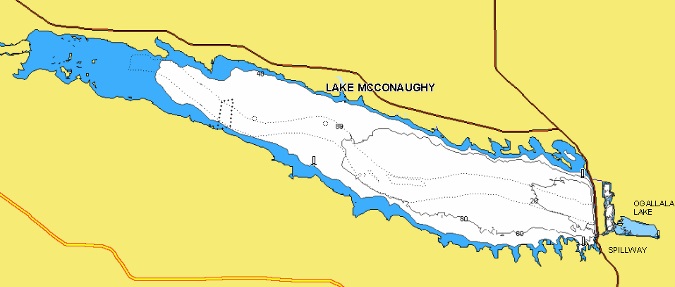
“Lake Mac” or “Big Mac,” as it is lovingly referred to by Nebraskans, is 22 miles long, 4 miles wide and is the state’s largest body of water.
The lake was formed on the North Platte River after construction of the Kingsley Dam was completed in the 1940s, with the primary goal of holding water for irrigating surrounding agricultural lands. Since, however, it’s become one of the top destinations for anglers and recreational boaters alike.
While Lake Mac holds hybrid striped bass, smallmouths, catfish and other gamefish species, along with a forage base consisting of alewives and gizzard shad, walleyes are the primary target among anglers—and for good reason. The population is not only healthy, but also contains good numbers of trophy-class fish.
Wildlife biologist and fishing guide Chad Richardson (Chad Richardson’s Fish The Plains guide service), has studied Lake Mac walleye behavior and has led hundreds of clients to amazing angling experiences. Here’s his advice on how to take advantage of the fish’s predictable movements throughout the year.
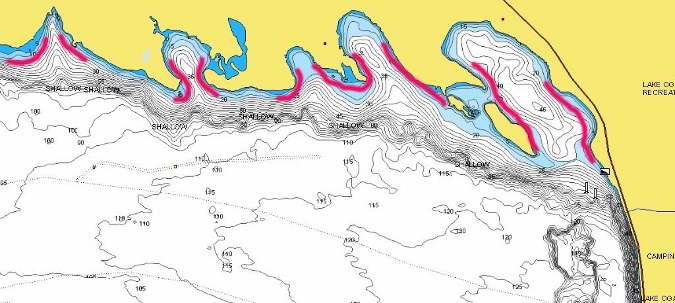
1. Lake Mac is so large and wind-swept that during the cold months its main body sometimes remains open throughout the winter. Theoretically this means hardy anglers could fish from boats straight through the year—if they could find a launch ramp that isn’t frozen solid. When an ice cover does form lake-wide, it’s typically too sketchy for anglers to fish safely.
Things don’t really start to roll until ice in the bays breaks up and launch facilities once again open up, according to the angler. Depending on the year, this could occur as early as late February, but whenever it happens walleye anglers normally start out targeting fish with vertical jigging presentations. Use sonar equipment to locate pods of walleyes, then try dropping a ¾-ounce Buck-Shot® Rattle Spoon, allowing it to settle just above the school. Jigging cadence can vary from subtle to aggressive and is something that must be worked out day-by-day and pod-by-pod.
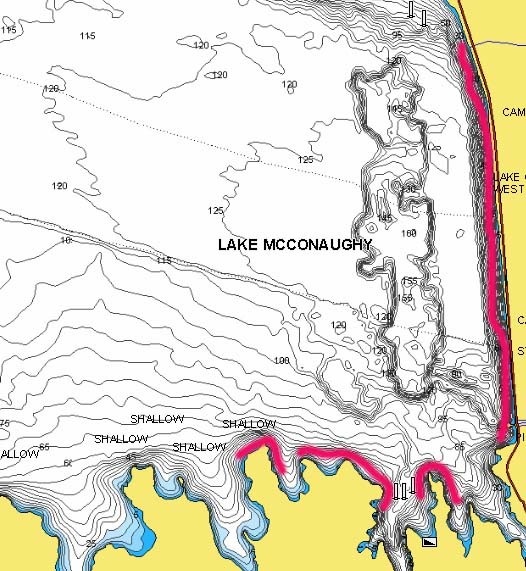 A second pattern also begins to emerge about this time, said Richardson; one that centers on shallower water along the sandy northern shoreline. “Walleyes are prespawn in February and March,” he says, “and there are some days when fish will venture into the shallows—anywhere in that 3- to 15-foot range—along the sandy shorelines and points. It can be spotty, but when the walleyes are there, you’ll catch a lot of fish.”
A second pattern also begins to emerge about this time, said Richardson; one that centers on shallower water along the sandy northern shoreline. “Walleyes are prespawn in February and March,” he says, “and there are some days when fish will venture into the shallows—anywhere in that 3- to 15-foot range—along the sandy shorelines and points. It can be spotty, but when the walleyes are there, you’ll catch a lot of fish.”
Focus on Martin Bay, on the dam’s north end, as well as the next four bays to the east. Try dragging or hopping a 1/8- to ¼-ounce (depending on water depth and wind conditions) Fire-Ball® Jig-and-live minnow, an RZ Jig tipped with an Impulse® Swim’n Grub or 3-inch Smelt Minnow, or an untipped Buck-A-Roo® Jig along the sandy bottom around the main points. “And don’t hesitate to work your way into the bays, either,” he adds. “Sometimes you’ll find them half-way, or even all the way, back there.”
2. April on Lake Mac is consumed by the spawn bite, according to Richardson. “Most walleyes spawn on the dam, and it’s a big draw for a lot of people, including shore anglers who don’t get many chances at a big fish.”
Trolling stickbaits and cranks along the 3-mile-long dam in the evening and after dark, or casting hardbaits from shore along the dam, are the most popular and productive approaches—though the willingness to fish in the crowd is a must. “It’s such a big deal that during that month it’s one-way traffic along the dam,” he says. “You troll south to north, then reel in and motor back down to get in line for another pass.”
If fishing with the pack isn’t your style, Richardson suggests trying the bays along the south shoreline near the dam. “They don’t get as much attention, but the first two or three coves feature steep breaks and rocky points, and some fish do spawn in these areas.”
Try casting or trolling hardbaits, or pitching jigs—as described above—in these areas, he says.
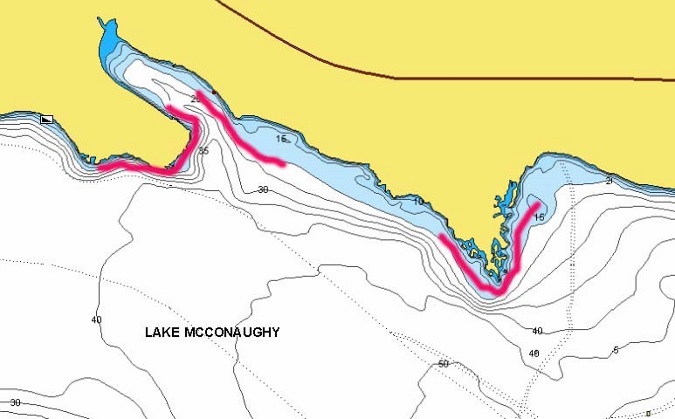
3. May brings a postspawn migration that has walleyes moving toward the upper end of the lake, and the major route lies along the north shoreline. The same sandy beaches and points where you found prespawn fish will hold walleyes again, but not for long. “The fish really move fast along here in May,” says Richardson. “It’s lucky to find them on any one spot for more than a couple of days.”
Walleyes tend to congregate around Sand and Otter Creek points on the northern shoreline during their westward journey, though individual pods may linger for only a short time. So, while you can locate fish anywhere along the northern route, this might be a good place to start.
Try trolling a 1½- to 2-ounce Rock-Runner® Bottom Bouncer trailing a spinner rig, plain hook or Screw-Ball Floater baited with a leech or nightcrawler in 15 to 25 feet of water. As the water is typically clear at this time, silver, brass, white or chartreuse blades and heads seem to work best. “I like to mix it up and experiment with all these options,” says Richardson, adding that stout hooks are in order because of the chance you might run into hard-fighting hybrid striped bass along the way.
Walleyes continue to move into the North Platte River, and when water levels allow, it’s possible to follow them upstream. But the main thing to remember is that fish are in transition. “The take-home message during this period is that you have to keep moving,” he says, “because the fish are.”
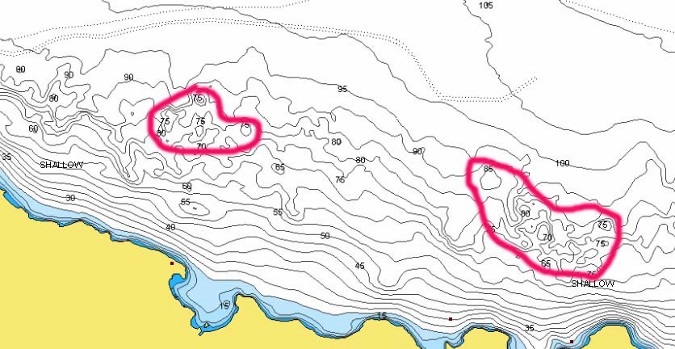
4. By late May water in the shallow western end of Lake Mac begins to warm, triggering walleyes to migrate back to deeper, cooler water. “Some tend to stay in the Otter Creek area, but the general migration seems to be to the east along the southern shore,” says Richardson.
For 15- to 20-inch eater-size walleyes, try trolling live bait rigs, as previously described, between the shoreline and the submerged timber farther out—favoring toward the trees. Bigger fish tend to hang in the timber and many anglers troll crankbaits over the tops of the trees. A unique approach, involving heavy (1½- to 2-ounce) spinnerbaits on lead core line, has also evolved on Lake Mac.
“The timber is in water anywhere from 25 to 45 feet deep, and big walleyes will suspend among the trees,” says Richardson. “Trolling a heavy spinnerbait allows you to target fish holding midway down the timber. It’s a good way to trigger strikes, but be prepared to lose some lures.”
June is also a good time to target smallmouth bass on Lake Mac, he says, adding that the lake holds big numbers of 12- to 15-inch fish, with plenty of 17s to 19s in the mix. Try pitching hair jigs, or ballhead jigs tipped with a live minnow or soft plastics along the steep, rocky points on the southern shoreline near the dam.
5. Walleyes continue to make their way east during the summer, and by August and into September, the fishing focus moves to deep humps and points along the southern shoreline. “Now they’re back in alewife country, and you’re looking for baitfish and walleyes near baitfish,” the angler explains. “They could be in open water, or related to deep structure or deep submerged timber.
To catch these fish, he suggests trolling the depths with crankbaits on lead core line, or going back to the cold-water tactic of vertically jigging heavy spoons. “This pattern holds into the fall and just gets better into October as fish move even closer to the dam,” he says. “Actually, you can fish this pattern right up until the launch ramps ice up again.”
The warm months are also prime time for hybrid striped bass. “Though they’re not overabundant, the quality is good, with lots of fish weighing in the teens.” says Richardson. Nighttime fishing is popular as hybrids tend to move shallow where they can coral baitfish. Try casting the back end of Martin Bay with a 4-inch Impulse® Smelt Minnow on a leadhead.
Vital Stats
Lake McConaughy
Size: 37,700 acres
Max Depth: 142 feet
Shoreline: 105 miles
Species Present: Walleyes, Hybrid Striped Bass, White Bass, Smallmouth Bass, Yellow Perch, Channel Catfish, Northern Pike, Bullheads, Alewives, Gizzard Shad
Lake Record Walleye: 16 lbs., 2 oz.
